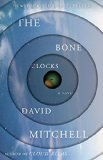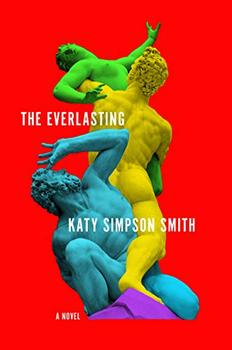Summary | Excerpt | Reviews | Beyond the book | Read-Alikes | Genres & Themes | Author Bio

A Novel
by David MitchellImagine being perched at the very top of a roller coaster ride. Picture that steep plunge down, the hair-raising twists and loops as you get sucked in and shaken about. Diving into The Bone Clocks feels much like this mad adrenaline rush. You don't just read a Mitchell novel, it grabs you and pulls you into a whirling vortex of complex plotlines. In true Mitchell style, he rewards faithful readers with stories about characters we have met before. For example, Hugo Lamb from Black Swan Green is back in one of the most memorable and gorgeously written pieces of writing I have ever read. If you are new to David Mitchell, fret not. The Bone Clocks is richly rewarding to both loyal fans and first-timers alike.
At the very center of this maelstrom is Holly Sykes who weaves in and out of the various plot arcs in direct and surprisingly tangential ways. As The Bone Clocks opens in 1984, teenaged Holly runs away from home, setting in motion a variety of events that will affect, not just her future, but the paths of many others across time, place and plane.
Yes...plane. Now stay with me for a bit here. You see, Holly has some kind of otherworldly, psychic connection to the paranormal; episodes which have plagued her from childhood that she and her family have come to recognize and live with. Who are these folks who connect with Holly and what do they want? The answer: Holly is a pawn in a war between two sets of people: The Atemporals and the Anchorites. The Atemporals are the good guys whose souls live on through an endless process of resurrection. The bad Anchorites are immortal, their bodies preserved in their prime, but they need to kill innocents to achieve this. Still there? Now, if this plotline has you salivating for more, great. But if you're thinking this is a tad too outlandish for your tastes, the good news comes in two parts: First, it was zany for me too and I still absolutely loved the book. Second, Mitchell packages it all neatly into one of six parts. While not recommended, you can neatly skip this section if you absolutely must.
An epic battle that takes place high on a mountain church in Switzerland between the Atemporals and the Anchorites is one of many epic twists and turns in this genre-defying novel. The book fast-forwards from its start in 1984 and ends in the year 2043 with Holly and her grandchildren merely surviving in Sheep's Head, a remote Irish peninsula ravaged by climate change, with even the Internet now a thing of the past. Along the way, we make pit stops in the years 1991, 2004, 2015, and 2024. We meet Hugo Lamb, a conniving student at Cambridge; Crispin Hershey, an insecure writer; and Ed Brubeck, a war reporter. Exactly how these characters play a role in the overall narrative is the magic that is teased out as you read along. The Bone Clocks travels to places far and near: Shanghai, La Fontaine Saint Agnes (in the Alps); Rottnest, Australia; Iceland and Iraq.
When a student writer in The Bone Clocks is asked about his upcoming novel, one gets a taste of Mitchell's wry sense of humor: "My hero is a Cambridge student called Richard Cheeseman, working on a novel about a Cambridge student called Richard Cheeseman, working on a novel about a Cambridge student called Richard Cheeseman. No one's ever tried anything like it." We get it. Mitchell knows how to poke fun at his own plot devices.
His command of language is breathtaking and invites rereading. Whether he's capturing a teenager's early disillusionment with life ("Being born's a hell of a lottery," Holly realizes), or capturing the wise-cracking, sarcastic banter of college students, he has a pitch-perfect ear for dialogue and descriptions. A quokka, a small Australian marsupial, for example, is described as "one heck of a Scrabble score." Mitchell is in his element everywhere - whether he's describing the quaintest Alpine ski resort (a section I have reread three times) or a semi-dystopian future in 2043.
The Bone Clocks is a powerful reflection on the ravages of time, be they on our own bodies (our bone clocks) or on the larger things that mold us into shape: family, friends, the environment. Life, one realizes, might be the stage where our drama unfolds, but the end result reminds us about what truly matters. "When I look at Brigadier Reginald Philby, I'm looking down time's telescope at myself," Hugo Lamb says when he visits a family friend at an old-age home, "Whatever I do with my life, however much power, wealth, experience, knowledge, or beauty I'll accrue, I, too, will end up like this vulnerable old man." Immortality is elusive, Mitchell reminds us, so how you play the game matters.
Writers work with mental maps, Crispin Hershey points out, and "it's the edges of these maps that fascinate." Even if the science-fiction/paranormal parts might read like Mitchell has gone off that edge altogether, this is an incredible rollercoaster ride and one heck of a novel. Don't miss it. It's David Mitchell's best gift yet to mere mortals, to bone clocks like you and me.
![]() This review was originally published in The BookBrowse Review in September 2014, and has been updated for the
July 2015 edition.
Click here to go to this issue.
This review was originally published in The BookBrowse Review in September 2014, and has been updated for the
July 2015 edition.
Click here to go to this issue.

If you liked The Bone Clocks, try these:

by Scott Alexander Howard
Published 2025
For fans of David Mitchell, Ruth Ozeki, and Kazuo Ishiguro, an elegant and exhilarating literary speculative novel about an isolated town neighbored by its own past and future, and a young girl who spots two elderly visitors from across the border: the grieving parents of the boy she loves.

by Katy Simpson Smith
Published 2021
From a supremely talented author comes this brilliant and inventive novel, set in Rome in four different centuries, that explores love in all its various incarnations and ponders elemental questions of good and evil, obedience and free will that connect four unforgettable lives.
Your guide toexceptional books
BookBrowse seeks out and recommends the best in contemporary fiction and nonfiction—books that not only engage and entertain but also deepen our understanding of ourselves and the world around us.